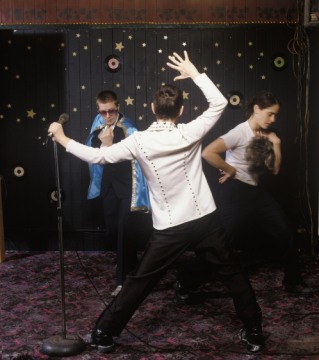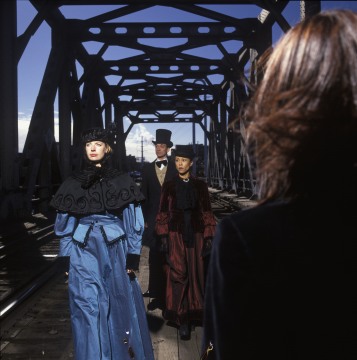New Dance: Momentum at the Southern
Lightsey Darst reviews Morgan Thorson and Jennifer Hart in the first week of the Walker Art Center/Southern Theater series of new local dance: "Momentum: New Dance Works." This weekend (July 22-24) Colin Rusch and Risa Cohen are up. Be there!


Morgan Thorson’s “Faker”
Is faking a bad thing? Consider a rehearsal: dancers run a few steps, stop, start over. They slip in and out of character, their need to perfect illusion almost an obsession. This type of faking we valorize as art.
Then consider, as Morgan Thorson does, a rehearsal on stage: house lights still on, dancers in their warm-up gear, slipping from fake performance to fake nonperformance. The need to get it right turns vicious as Kristin Van Loon repeats and expands a series of magical gestures; faking as neurosis, maybe, but a neurosis that leads to dance. House lights go down and the real Elvis imitation begins: Karen Sherman, in a white jumpsuit, jerks and grinds with two back-up cowgirls (one a shiny, happy Van Loon). But we’re not safely in fake Graceland; a lone cowgirl, Joanna Furnans, remains, falls out of character, and echoes the earlier complaint of Chris Schlichting that “this isn’t what we talked about!” As soon as she does, Schlichting comes onstage and challenges her.
We realize that this bit belongs to Schlichting, and that Furnans is faking Schlichting, who now wears a T-shirt printed with his own photograph, and flexes his shoulders, making the image bounce. When Sherman pulls on a similar self-shirt over her Elvis belt, the message is compounded: being yourself is as fake as being anyone else.
But don’t worry, Thorson isn’t going to beat on this long-discovered lie. When Furnans and Schlichting make out, with Furnans’s hand interposed, Furnans carries on making out through her hand even after Schlichting has stepped away. You can see her as self-absorbed, in love with faking it—or imagine that her love for love transcends and redeems the fakery.
Following this, four dancers copy gestures from TV—as if to look at or like a thing were to become it. But how do we ever become anything, if not by some initial faking; how else could anyone learn? Thorson builds episode after episode on the theme of faking, coming at the idea from all sides, until finally Furnans and Van Loon, having survived a fake breakdown, are left dancing to Bruce Springsteen in their underwear, as if they were sixteen and in their bedrooms. Thorson’s taken us to the root of fake—liking, wanting—and it’s not a bad place. Furnans and Van Loon spring into balletic leaps and the lights go out.
How does Thorson accomplish this perfect thesis on the genesis, practice, and ethics of fake, covering both art and identity? Three elements stand out. First, Thorson’s use of music. It’s not only her broad selection—from Electric Light Orchestra to Strauss to the live drumming of Ryan Billig—or her integration of music into other elements of performance—dramatic Beethoven while the dancers, lit from low frontal sources, copy moves from TV screens. Thorson finds music inside music: the genuine love lurking in sappy ballads, the heroism in pumped-up anthems. She does this by interpreting music literally, by doing what the rhythms and words suggest, playing with rather than being bound to traditional interpretations. In Thorson’s best Elvis impression, Sherman spasms to “Burning Love,” then spreads her legs into a lunge, one thumb in the air, and slowly pivots. This shiver and nearly unmoving grind gets to the sex appeal of Elvis and his music: his timing, the sense that he’s going to make you wait for it, but it’ll be worth the wait. It’s funny that Thorson does so little to this music, but also moving; she trusts what she does.
Second, there’s Thorson’s ability to add elements—dance, music, speech, costume, light, projection/video—together until she’s created a scene, layered with meaning, irresistibly accessible, that no one could conceive or entirely understand in a moment. A performer drags a drum kit onstage; a drummer starts playing and Sherman dances. She’s given a TV with a picture of roses as her prize (the TVs are already on stage). But the drummer’s not done; he jerks Sherman around, beat after beat, until she’s on the floor, spent.
Schlichting joins her; microphones appear, angled toward them; they begin to sing. Meanwhile Thorson projects the lyrics on the wall behind them. They’re singing “Love Lift Us Up Where We Belong” from a prone position, these beat-up fakers, singing the lyrics off a brick wall, Schlichting still wearing his self-shirt. Later the same televised roses alternate with “R. I. P.” to signal Elvis’s death. Watching Thorson work must be like watching a magpie; everything shiny, everything counter, original, spare, is useful.
Finally, there are Thorson’s dancers, who are notable not for traditional qualities, but for their ability to be on stage. Kristin Van Loon’s wiry body can do it all, but she’s wonderfully watchable because she gives the sense of happening on stage. She can afford to use grace, which is some dancers’ sole strength, as mere texture, a winsome ironic flourish. Beyond his dancing, Chris Schlichting projects vulnerability and a need to be loved (which the audience answers). Joanna Furnans communicates directly, as if she were telling this story to a friend. Karen Sherman plunges into music at the nerve level, her stamina nearly incidental. (Amanda Furches and Morgan Thorson also performed, but danced much less.) The ending leap that Furnans and Van Loon throw into the dark isn’t technically perfect, but it’s sweeter for its flaws.
But how Thorson does it is less important than that she does. Thorson’s last appearance at the Southern was nearly two years ago; how long do we have to wait for her to come back?
Jennifer Hart
Coming second, Jennifer Hart’s brooding modern ballet suffers in comparison to Morgan Thorson’s postmodern carnival; watching the two in this order is like eating dinner after a banana split. Colin Rusch’s work (showing in Momentum’s next weekend) would have been a better partner, but presumably, this wasn’t in Hart’s control—unlike her choreography.
Modern ballet isn’t a universal favorite. Part of the argument against it is that modern ballet frequently co-opts ballet’s beauty without taking any of its framing, its discipline, and, under the guise of setting beauty free, fills the stage with one distended and meaningless line after another. I agree at the same time that I don’t trust this argument: are we just jealous of this license to be beautiful? But, at any rate, Jennifer Hart takes this form in a different direction. In “Song,” a melting vignette performed by Hart and Sam Feipel to a familiar Beethoven adagio, Hart brings out the adolescent ugliness inherent in ballet. Ballet’s long bodies reveal themselves as bent clothes-hangers; second position becomes an awkward, intimate grab for air; ballet’s turn-out is a teenage girl’s stiff idea of virtue. Hart isn’t criticizing ballet, though. “Song” is a lovely piece whose occasional ugliness gives it a tingling realism. It’s August and these two seventeen-year-olds are breaking up, or getting together, or arguing about going all the way—a familiar intersection of heat, sexual frustration, fear, and need.
“The Station” is less successful. In this longer meditation on the limbo we sometimes find ourselves in while we wait for something to happen, Hart proves she can move a chorus; her seven innocent passengers ripple in a canon that’s not new but so well done, a flickering start-stop of emotion trembling to Philip Glass and Arnold Schoenberg’s wracked music. Here, as in “Song,” Hart’s modern ballet is distinctive. Instead of using only ballet lines, Hart shows actual steps, the intricate connective tissue that gives form and meaning to ballet’s explosions. Seeing steps, you wonder why so many modern ballet choreographers deprive us of their variety, their potential expression of the hundred inflections of a single emotion.
Still, “The Station” lacks a dimension. I wish Hart felt a little more freedom with her music. Glass’s unrelenting impending doom doesn’t resonate quite so well as it once did, having been replaced by our current sense that war and beauty are two spokes on a perpetually spinning wheel. By using a wider variety of music, Hart could layer the prevalent emotion with another mood. While her , she depends on a two-point narrative—at the beginning, the innocents find themselves in a limbo ruled by a malevolent spirit; at the end, they escape—a third distinct event would help sustain tension.
Hart’s dancers show varying degrees of excellence. Sam Feipel combines grace, excellent partnering, and natural stage presence. More breath than dance, Jessica Cressey’s movements flow organically, arising from her character and situation. Peggy Seipp, on the other hand, is so lost in the tense emotion of “The Station” that she’s less a person with a feeling that an embodiment of feeling. Out-of-towner Sara Kaproff plainly enjoys her role as the magenta-corseted sprite, but she’s more playing evil than being evil, perhaps because she has so little to do. Eric Boone’s almost a liability in a corps, as his weighted intensity always suggests that he’s about to do something. Stephanie Fellner, Abdo Sayegh, and Kari Schire also performed well.